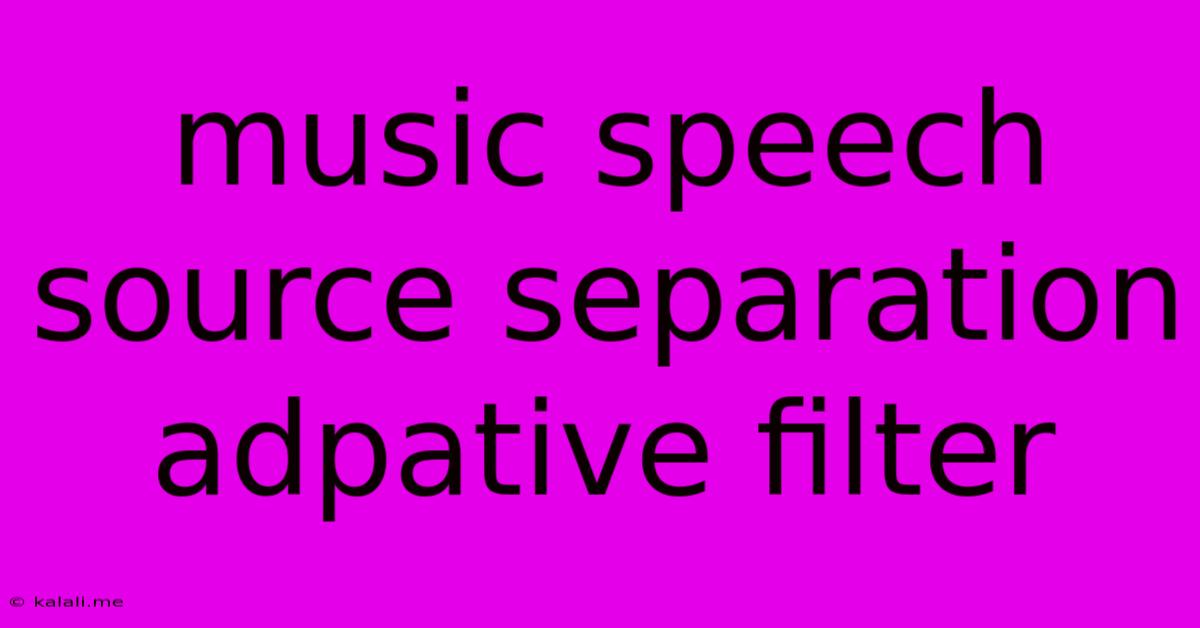Music Speech Source Separation Adpative Filter
Kalali
Jun 04, 2025 · 3 min read

Table of Contents
Music Speech Source Separation using Adaptive Filters: A Deep Dive
Meta Description: Learn about the powerful technique of adaptive filtering for separating speech from music, exploring its algorithms, advantages, and challenges in the context of audio signal processing. Discover how this method enhances speech intelligibility in noisy environments.
Speech source separation from complex audio mixtures, like music and speech, is a significant challenge in audio signal processing. This is crucial for applications ranging from hearing aids to automatic speech recognition (ASR) systems operating in noisy environments. One effective approach employs adaptive filtering, a technique that dynamically adjusts filter parameters to optimize the separation process. This article delves into the principles and applications of adaptive filters for music and speech source separation.
Understanding Adaptive Filters
Adaptive filters are digital filters whose coefficients are adjusted automatically based on incoming signals. Unlike fixed filters, which have pre-defined frequency responses, adaptive filters learn the characteristics of the input signals and adapt their response accordingly. This adaptability makes them exceptionally well-suited for separating sources in non-stationary environments where the characteristics of the music and speech signals can change over time.
Several algorithms power adaptive filters, each with strengths and weaknesses:
-
Least Mean Squares (LMS) Algorithm: A simple and widely used algorithm, LMS iteratively updates filter coefficients to minimize the mean squared error between the desired signal (e.g., speech) and the filter output. Its simplicity comes at the cost of slower convergence compared to other algorithms.
-
Normalized Least Mean Squares (NLMS) Algorithm: An improved version of LMS, NLMS normalizes the input signal, leading to faster convergence and robustness against variations in signal power.
-
Recursive Least Squares (RLS) Algorithm: RLS offers faster convergence than LMS and NLMS, but at the expense of increased computational complexity. It's particularly beneficial when rapid adaptation is required.
-
Affine Projection Algorithm (APA): APA offers a compromise between the computational complexity of RLS and the convergence speed of LMS/NLMS. It considers multiple past input vectors to improve convergence and tracking performance.
Applying Adaptive Filters to Music and Speech Separation
The core concept involves using a reference signal (often a noisy mixture of music and speech) and a desired signal (ideally, a clean speech signal) to train the adaptive filter. The filter learns to minimize the error between the filter output and the desired speech signal. This results in a filter that effectively removes the music component while preserving the speech.
A common approach employs a two-channel system: one channel captures the mixed audio (music and speech), while the other might employ a microphone close to the speaker's mouth for a cleaner speech reference signal. This reference signal helps guide the filter's adaptation process, suppressing the music and enhancing the speech signal.
However, obtaining a clean speech reference signal is often impractical in real-world scenarios. Blind source separation techniques attempt to address this limitation. They estimate the speech component from the mixture signal itself, often using statistical models or other advanced signal processing techniques.
Challenges and Future Directions
While adaptive filtering offers a powerful approach, challenges remain:
-
Computational Complexity: Certain algorithms, especially RLS, can be computationally intensive, limiting their applicability in real-time applications with strict latency constraints.
-
Musical Instrument Interference: The separation of speech from complex musical instruments can be difficult, especially when the instrument's frequencies overlap with the speech spectrum.
-
Reverberation and Echo: Room acoustics can significantly impact performance. Reverberation and echo can obscure the speech signal, making separation more challenging.
Future research focuses on improving the robustness and efficiency of adaptive filters, exploring hybrid approaches that combine adaptive filtering with other signal processing techniques like spectral subtraction or independent component analysis (ICA). The development of more sophisticated algorithms that can handle complex acoustic environments and various musical instruments is a key area of active investigation. Deep learning techniques are also gaining significant traction, offering potential for more accurate and robust music and speech source separation. The ability to efficiently and accurately separate speech from music will continue to drive innovation across a range of applications.
Latest Posts
Latest Posts
-
There Is A Beast Beneath The Boards
Jun 06, 2025
-
Building A Level Concrete Slab On A Slope
Jun 06, 2025
-
What Can I Use As A Mousepad
Jun 06, 2025
-
Cat Poops In Litter Box But Pees On Floor
Jun 06, 2025
-
Max Wattage To Charge Macbook Pro
Jun 06, 2025
Related Post
Thank you for visiting our website which covers about Music Speech Source Separation Adpative Filter . We hope the information provided has been useful to you. Feel free to contact us if you have any questions or need further assistance. See you next time and don't miss to bookmark.